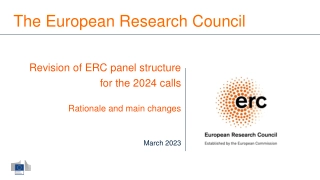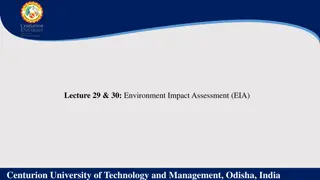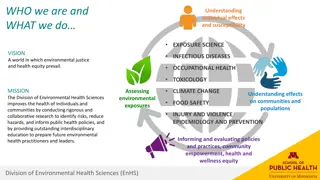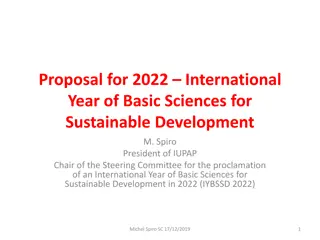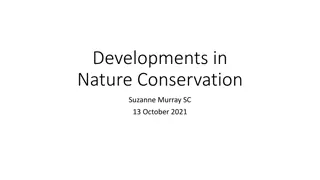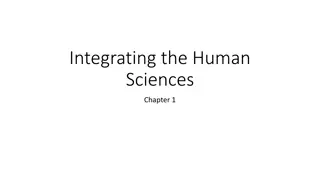Understanding Impact Analysis in Environmental Sciences
Impact analysis, presented by Saman Sana, explores the importance of identifying and evaluating environmental changes resulting from project implementation. The Environmental Impact Assessment (EIA) process involves screening, scoping, impact analysis, and prediction phases to forecast and evaluate potential impacts. Tools and techniques like checklists and matrices aid in impact identification, while drawbacks such as adhoc methods are recognized. Enhancing methodologies like checklists can improve impact assessment accuracy.
Download Presentation

Please find below an Image/Link to download the presentation.
The content on the website is provided AS IS for your information and personal use only. It may not be sold, licensed, or shared on other websites without obtaining consent from the author. Download presentation by click this link. If you encounter any issues during the download, it is possible that the publisher has removed the file from their server.
E N D
Presentation Transcript
Impact Analysis Presented By: Saman Sana Lecturer Department of Environmental Sciences University of Veterinary and Animal Sciences
What is Impact? A change in parameters over a specified period within a defined area resulting from a particular activity compared with the situation which would have occurred had the activity not been implemented. Impact Assessment It refers to the identification and evaluation of environmental changes occurring as a result of implementing a project Environmental impact parameters
The screening phase of EIA determines whether or not an EIA is required for a particular proposal. The scoping phase identifies the important issues that should be investigated in detail (making sure that time and money is not wasted investigating issues that are not of concern). The next stage of the EIA process is when a detailed assessment is undertaken to forecast the characteristics of the main potential impacts. Known as impact analysis, this stage can be broken down into 3 overlapping phases: Analysis 3 Phases of Impact Identification Prediction Evaluation
Impact analysis is the technical heart of the EIA process. Identification: to specify the impacts associated with each phase of the project and the activities undertaken; 1) Prediction: to forecast the nature, magnitude, extent and duration of the main impacts; and 2) Evaluation: to determine the significance of the residual impacts i.e. after taking into account how mitigation will reduce a predicated impact. 3) Tools & Techniques for Impact Identification Adhoc method Checklist Matrices Networks Overlays and geographic information system (GIS) Expert systems
Drawbacks: Adhoc Method It may not encompass all the relevant impacts Criteria used to evaluate impacts are not comparable and can not be replicated Team of experts assembled for a short time to conduct an EIA Each expert s conclusions are based on a unique combination of experience, training and intuition This approach was followed immediately after the enactment of NEPA
Checklists These annotate the environmental features and factors that need to be addressed when identifying the impacts of projects or activities. These can vary in complexity and purpose, from a simple checklist to a structured methodology or system that also assigns significance by scaling and weighting the impacts Checklists could be improved and adapted to suit local conditions as experience with their use is gained.
Checklists provide a systematized means of identifying impacts They also have been developed for application to particular type of projects and categories of impacts (such as dams or road building). Sectoral checklists often are useful when proponent specialize in one particular area of development. Types of checklists Simple checklist Descriptive Checklist Scaling Checklist Weighting-Scaling Checklist Questionnaire Checklist Disadvantages of checklists: Ineffective in identifying higher order impacts or inter- relationships between impacts
A list of environmental parameters with no guidelines on how they are to be measured and interpreted Simple checklists Add to simple checklists as they not only list the aspects to be considered but provide additional background information on each aspect Descriptive checklists It is similar to a descriptive checklist , but with additional information on subjective scaling of the parameters Scaling checklists It is similar to scaling checklist, with additional information for the subjective evaluation of each parameter with respect to all the other parameters Scaling weighing checklists Questionnaire checklists These are composed of a series of questions that highlight potentially relevant issues
Matrices A matrix is a grid like table that is used to identify the interaction between project activities, which are displayed along one axis, and environmental characteristics, which are displayed along the other axis. The Leopold matrix is the best known matrix methodology available for predicting the impact of a project on the environment. The method uses a matrix with 100 specified actions and 88 environmental items (LEOPOLD et al. 1971) These are basically generalized checklists.
Overlays and geographic information system (GIS) Overlays can be used to map impacts spatially and display them pictorially. The original overlay technique, popularized by McHarg, is an environmental suitability analysis in which data on topographic features, ecological values and resource constraints are mapped onto individual transparencies and then aggregated into a composite representation of potential impacts.
Advantages Disadvantages This approach is useful for Lack of precision in comparing site and planning differentiating the likelihood alternatives, and magnitude of impacts and relating them to project For routing linear actions. developments to avoid environmentally sensitive Overlay process can become areas and for landscape and cumbersome in its original habitat zoning at the regional form. level.
A modern version of overlay method is Drawbacks: lack of appropriate data & expense of creating a useful system the computer based geographical information system (GIS). In simple terms, a GIS stores, retrieves, However, application of GIS to EIA is widely acknowledged and its use is expected to increase in future, particularly Cumulative Effects. the potential manipulates and displays environmental data in spatial format. to address A set of map or overlays of a given area provide different types of information and scales of resolution. The use of GIS for EIA purposes is not as wide spread as commonly imagined.
Networks Cause Effect Relationship Networks illustrate cause effect relationship of project activities and environmental characteristics. They are therefore, particularly useful in identifying and depicting secondary impacts (indirect and cumulative etc.). Simplified networks, used in conjunction with other methods, help to ensure that important second order impacts are not omitted from the investigation. More detailed networks are visually complicated, time consuming and difficult to produce unless a computer program is used for the task. However, they can be useful aid for establishing impacthypothesis and other structured science based approaches to EIA.
Expert system Expert or knowledge based systems are used to assist diagnosis, problem solving and decision making. A number of such computerized systems have been developed for use in EIA, primarily at the early stages of the process. The user has to answer a series of questions that have been systematically developed to identify impacts and determine their mitigability and significance. Like GIS system, expert systems are an information intensive, high investment method of analysis, As such, they are limited in their current use and application, especially by many developing countries. Based on the answer given to each question, the expert system moves to the next appropriate question.
Main advantages and disadvantages of impact identification methods Method Advantages Disadvantages do not distinguish between direct and indirect impacts do not link action and impact the process of incorporating values can be controversial easy to understand and use good for site selection and priority setting simple ranking and weighting Checklists difficult to distinguish direct and indirect impacts have potential for double-counting of impacts link action to impact good method for displaying EIA results Matrices link action to impact useful in simplified form for checking for second order impacts handles direct and indirect impacts can become very complex if used beyond simplified version Networks easy to understand focus and display spatial impacts good siting tool can be cumbersome poorly suited to address impact duration or probability Overlays excellent for impact identification and spatial analysis good for experimenting heavy reliance on knowledge and data often complex and expensive GIS and computer expert systems
No single impact identification methodology is suited to use on all occasions; nor is it necessary to use only one method at a time. Combining the useful aspects of two different techniques may be the best approach to take. EIA checklists, matrices and networks can have added value when applied by experts in an interactive process. Note, also that some of the methods perform other functions that may be useful to the EIA team (e.g. the Battelle checklist can be used to determine significance).
No single impact identification methodology is suited to use on all occasions; nor is it necessary to use only one method at a time. Combining the useful aspects of two different techniques may be the best approach to take. Selection of Tool/Technique The choice of methodology can depend upon a number of factors including: 2) The type of alternatives being considered 1) The type and size of the proposal 3) The nature of the likely impacts 5) The experience of the EIA team & 4) The availability of the impact identification methods 6) The resources available- cost, information, time, personnel
Impact Analysis/Prediction Once all the important impacts have been identified, their potential size and characteristics can be predicted. Impact prediction and forecasting is a technical exercise. It utilizes physical, biological, socio-economic and cultural data to estimate likely characteristics and parameters of impacts (e.g. magnitude, spatial occurrences etc.)
Characteristics of Environmental Impacts nature (positive, negative, direct, indirect, cumulative) duration (short term, long term, intermittent, continuous) magnitude (severe, moderate, low) reversibility/irreversibility extent/location (area/volume covered, distribution) likelihood (probability, uncertainty or confidence in the prediction) and timing (during construction, operation, decommissioning, significance (local, regional, global) immediate, delayed, rate of change)
Nature The most obvious impacts are those that are directly related to the proposal, and can be connected (in space and time) to the action that caused them. Typical examples of direct impacts are: destruction of habitat caused by forest clearance; relocation of households caused by reservoir impoundment; increased air particulate emissions caused by operation of a new power station, etc.
Indirect or Secondary Impacts These are changes that are usually less obvious, occurring later in time or further away from the impact source. Examples of these types of impacts are: the spread of malaria as a result of drainage schemes that increase standing water and thereby create new vector habitat; bio-accumulation and bio-magnification of contaminants in the food chain through take up of agricultural pesticides; and anxiety, stress and community disruption associated with increased traffic volumes and noise caused by road development.
Cumulative effects Typically, result from the incremental impact of an action when combined with impacts from projects and actions that have been undertaken recently or will be carried out in the near or foreseeable future. These impacts may be individually minor but collectively significant because of their spatial concentration or frequency in time. Cumulative effects can accumulate either incrementally (or additively) or interactively (synergistically), such that the overall effect is larger than the sum of the parts.
Magnitude Extent/Location Estimating the magnitude of the The spatial extent or zone of impact impact is of primary importance. influence can be predicted for site- Typically, it is expressed in terms specific versus regional occurrences. of relative severity, such as major, Depending on the type of impact, moderate or low. Severity, as the variation in extent/location will opposed to size, also takes account need to be estimated; of other aspects of impact for example: alterations to range or magnitude, notably whether or not pattern of species or dispersion of an impact is reversible and the air and water pollution plumes. likely rate of recovery.
Timing Significance Impacts arising from all of the The evaluation of significance at stages of the life cycle of the this stage of EIA will depend on project should be considered (i.e. the characteristics of the predicted during construction, operation and impact and its potential decommissioning). Some impacts importance for decision-making. will occur immediately, while Significance is usually attributed others may be delayed, sometimes in terms of an existing standard or by many years. These impact criteria of permissible change, for characteristics should be noted in example as specified in a standard, the EIA report. policy objective or plan.
Duration Some impacts may be short-term, such as the noise arising from the operation of equipment during construction. Others may be long-term, such as the inundation of land during the building of a reservoir. Certain impacts such as blasting may be intermittent, whereas others, such as electromagnetic fields caused by power lines, may be continuous. Impact magnitude and duration classifications can be cross-referenced; for example, major but short term (less than one year), low but persistent (more than 20 years).
Impact Characteristics Summary Table Impact Impact Type Health Characteristics Air quality Etc. Nature Magnitude Extent/location Timing Duration Reversibility Likelihood (risk) Significance
Impact Prediction Methodologies Several techniques can be used in predicting the impacts. The choices should be appropriate to the circumstances. These can be based on: Professional judgment with adequate reasoning and supporting data. This technique requires high professional experience Experiments or tests. These can be expensive Past experience Numerical calculations & mathematical models. These can require a lot of data and competency in mathematical modelling without which hidden errors can arise Physical or visual analysis. Detailed description is needed to present the impact. Geographical information systems Risk assessment and Economic evaluation of environmental impacts
Methods for Predicting the Characteristics of Impacts Experiments and physical models Best estimate professional judgement Predicting the Characteristics of Impacts Quantitative mathematical models Case studies as analogues or points of reference
Types of Uncertainties in Impact Prediction Scientific uncertainty: limited understanding of the ecosystem or community affected Data Policy uncertainty: unclear or disrupted objectives or standards uncertainty: incomplete information or insufficient methodology Approaches to Address Uncertainties in Impact Prediction Best and worst case prediction to illustrate the spread of uncertainty Sensitivity analysis to determine the effect of small changes in impact magnitude Attaching confidence limits to impact predictions; and
Evaluation of impact significance Impact characteristic (magnitude) M Impact importance (value) I Impact significance S X M X I = S
Key Elements for Assessing Impact Significance Environmental standards, guidelines & objectives Scientific and professional evidence concerning: Level of public concern Test of Significance by Asking Three Questions Resource loss/ecological damage i. Are there residual environmental Negative social impacts impacts? Foreclosure of land and resource ii. If yes, are these likely to be use options significant or not? iii. If yes, are these significant effects likely to occur?
Impacts are likely to be significant if they: Are expensive over space or time Are intensive in concentration or in relation to assimilative capacity Exceed environmental standards or thresholds Do not comply with environmental policies/ land use plans Affect ecological sensitive areas and heritage resources Affect community lifestyle, traditional land use and values



